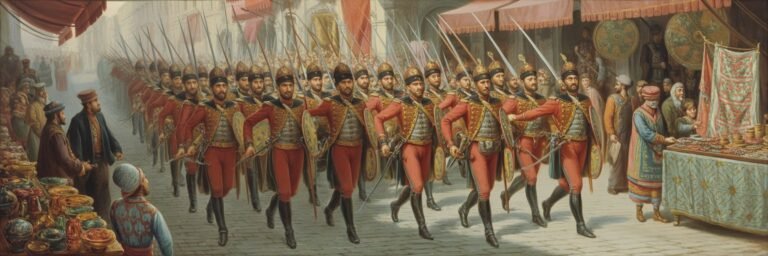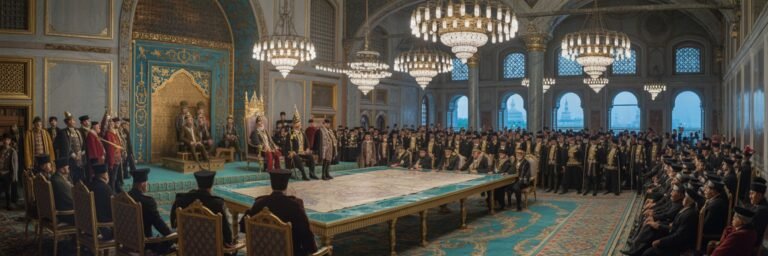INTRODUCTION
The Ottoman Empire, sprawling across three continents for over six centuries, marks one of history’s most enduring, influential, and controversial regimes yet. From its establishment under Osman I in the 13th century to its collapse in the aftermath of World War I, few empires were as captivating as this multi-ethnic and multi-religious behemoth. It was a nexus of power, culture, religion, and history whose echoes still resonate today – an enthralling stage on which sultans, diplomats, and artists showcased their myriad talents.
Yet, whilst the Ottoman Empire’s fall is a well-known historical spectacle, many of its complexities remain untold. This extensive feature seeks to unravel the intricate tapestries of this intriguing civilization by navigating its storied past through multiple angles: academic interpretations, mysterious episodes, cultural symbolism, modern investigations, and its enduring legacy.
HISTORICAL BACKGROUND
The tale of the Ottoman Empire began under the leadership of Osman I, a tribal leader from Anatolia who established its nascent roots in 1299. The empire’s early expansion was driven by a combination of shrewd diplomacy, military prowess, and the weakening of neighboring powers. Notable milestones were the taking of Bursa in 1326, which became the empire’s first capital, and the capture of Constantinople under Mehmed the Conqueror in 1453, marking the end of the Byzantine Empire.
In the 16th and 17th centuries, the empire experienced its zenith under Sultans like Selim I and Suleiman the Magnificent. The empire’s domains spanned three continents, stretching from Hungary in the north to Somalia in the south, and from Algeria in the west to the Persian Gulf in the east.
However, the empire slowly but surely declined due to a confluence of reasons ranging from internal strife, military defeat, economic woes, and increasing pressure from European powers. By the late 17th century, the empire was deemed the “Sick Man of Europe”. Its final collapse came after World War I, leading to the creation of modern-day Turkey.
THEORIES AND INTERPRETATIONS
Different scholars harbor various interpretations of the empire’s rise and fall. One school of thought, championed by Stanford J. Shaw, argues that a strong central authority characterized by effective rule and administration largely contributed to the empire’s growth. Meanwhile, other historians like Halil Inalcik present a contrasting view, attributing Ottoman growth to its powerful military apparatus and its ability to synthesize different cultures and practices.
As for the empire’s decline, the centralist decline theory posits that ineffective central governance and corruption contributed heavily to its fall. However, Baki Tezcan, a revisionist scholar, contends that the decline was not a complete deterioration but rather a transformation or, as some put it, a period of crisis and adaptation better reflecting the empire’s changing nature.
MYSTERIES AND CONTROVERSIES
The Ottoman Empire was not without its controversies and mysteries. At the heart of the intrigue is the puzzling fratricidal law instituted by Mehmed the Conqueror, permitting the incoming Sultan to murder his brothers to prevent succession disputes. This merciless but pragmatic law, although rescinded eventually, is one of many factors contributing to the empire’s fierce reputation.
Another controversial aspect is the Armenian Genocide, with debates still rife over whether the mass killings of Armenians by the Ottoman Turks during World War I should be classified as genocide. Though the event is recognized as such by many nations, Turkey, the Ottoman Empire’s modern successor, vehemently denies the charge.
SYMBOLISM AND CULTURAL SIGNIFICANCE
The Ottoman Empire was a cultural kaleidoscope, thanks to its diversity and cosmopolitan spirit borne from its multicultural populace and vast territories. Its impact is seen in various symbols and their cultural significance. The flag, adorned with a star and crescent, has evolved to become an iconic symbol of Islam, despite predating the empire and having pagan origins.
Architecture also played a prominent role, with examples such as the Hagia Sophia and the Blue Mosque, each a testament to the rich culture and exquisite artistry of the era. The empire’s legacy also left indelible marks on music, literature, and cuisine, which borrowed, blended, and enhanced practices, resulting in a tangible cultural richness still apparent today.
MODERN INVESTIGATIONS
Modern investigations into the Ottoman Empire continue to yield fruitful insights. Scholars like Caroline Finkel challenge the idea of ‘decline’ often associated with the empire, reevaluating this period as one of significant change and adaptation. Meanwhile, Quataert’s research into Ottoman social and economic history has revolutionized our understanding of the working populace and the nuanced labor dynamics within the empire.
Forensic anthropologists and archaeologists, like Clark Spencer Larsen, have also focused on the empire’s osteological remnants to investigate lifestyle, health, and genetic details. Such investigations breathe new life into the empire’s narrative, recalibrating how history is understood and taught.
LEGACY AND CONCLUSION
The Ottoman Empire’s legacy is intertwined with the modern world. Its footprints can be observed in present-day Turkey, the Balkans, the Middle East, and North Africa. The Turkish language, Ottoman laws, and administration still influence these regions’ culture, legal systems, language, and architecture.
Amidst this, the empire’s spiritual legacy is notable as it was the last Sunni Caliphate, a political-religious authority revered by the Islamic world, which was abolished in 1924. This symbolism resonates with Muslims worldwide, leading to debates about the restoration of the Caliphate.
The storyline of the Ottoman Empire is captivating, complex, and pertinent. Enveloped in scholarship, mystery, cultural significance, modern investigations, and a lasting legacy, its rich tapestry continues to reveal intriguing insights into our shared past, reminding us about the intricate dance between power, culture, and history. In many ways, the untold story of the Ottomans is a testament to the transcendent power of human civilization, enduring across time, space, and memory.






